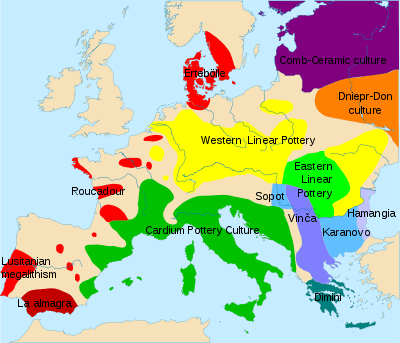Bug–Dniester culture
The Bug–Dniester culture was the archaeological culture that developed in the chernozem region of Moldavia and Ukraine around the Dniester and Southern Bug rivers in the Neolithic.

| Part of a series on |
| Indo-European topics |
|---|
 |
|
|
Philology
|
|
Origins |
|
Archaeology Pontic Steppe
Caucasus East Asia Eastern Europe Northern Europe Pontic Steppe Northern/Eastern Steppe Europe
South Asia Steppe Europe Caucasus India |
|
Peoples and societies Indo-Aryans Iranians
East Asia Europe East Asia Europe
Indo-Aryan Iranian
|
|
Religion and mythology
Indo-Aryan Iranian Others Europe
|
|
Over approximately 1,000 years, 6300–5500 BC, the Bug–Dniester culture metamorphosed through different cultural phases, but the population remained about the same. What is most noteworthy about the Neolithic in this region is that it developed autochthonously from the Mesolithic there, through contact with the Chalcolithic cultures in the west and Neolithic hunter gatherer cultures in the East (Here Neolithic is defined as pottery-bearing, not agricultural). The people in this region relied predominantly on hunting aurochs, red deer, roe deer and boar, and fishing for roach, eels and pike. They made pottery from about 6200 BC. This type of pottery made by hunter-gatherers had arrived in the middle Volga from the Lake Baikal region of Asia. One notable characteristic is that many pots had pointed bottoms, designed for cooking over a fire. They could be decorated in patterns of wavy lines.[1]
This local culture was influenced by the neighboring Neolithic Criş culture, whose origins lay in the Carpathian basin.[2] The Criş farmers arrived in the upper valleys of the Seret and Prut about 5800–5700 BC. Criş pottery forms were copied by the Bug–Dniester people. Wild grasses were abandoned in favor of einkorn, emmer and spelt. Cattle-breeding was adopted.[3] Some of the earliest known evidence for domesticated plants and animals during the Neolithic found in the Ponto-Caspian Steppe are the pig and cattle bones and barley and emmer at Bug–Dniester sites.[4]
References
- David W. Anthony, The Horse, the Wheel, and Language (2007), pp. 147–149 and fig. 8.5.
- David W. Anthony, "Persistent identity and Indo-European archaeology in the western steppes" (2001). In Carpelan, Parpola, & Koskikallio (eds.), Early Contacts between Uralic and Indo-European: Linguistic and Archaeological Considerations. Mémoires de la Société Finno-Ougrienne 242; Helsinki 2001: Suomalais-Ugrilainen Seura, pp. 11–35.
- David W. Anthony, The Horse, the Wheel, and Language (2007), pp. 140, 147–151.
- Kuzmina, E.E. The Prehistory of the Silk Road. University of Pennsylvania Press. p. 16.